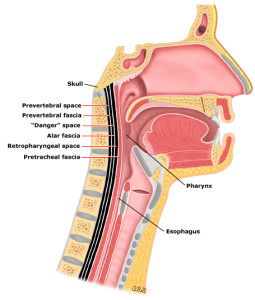Deep Space Neck Infections!
Anatomy
Image from:
Types
Peritonsillar space (abcess)
Parotid space
Submandibular space (Ludwig’s angina)
Pretracheal space
Prevertebral space
Parapharyngeal space
Retropharyngeal & danger space
History & Physical Exam Findings
– Dysphagia – Drooling
– Odynophagia – Paratonsillar or pharyngeal bulge
– Dyspnea +/- stridor if airway obstruction present – Displaced uvula
-Toxic appearance – Trismus
– Fever – Unilateral tongue paresis
– Muffled or hoarse voice
Imaging
Lateral neck XR
- Prevertebral soft tissue should be less than 5mm or <1/3 the width of C4 vertebral body
Bedside ultrasound
- Can be used to search for a fluid collection suggesting underlying abcess
CT Neck & Chest
Microbiology
Polymicrobial – consider flora from source of infection
- Anaerobic predominance with anterior soft tissue infections that infiltrate the deep neck space
- viridians, S. pyogenes, Fusobacterium, Peptostreptococcus, Prevotella
- Gram + predominance with vertebral infections that advance into prevertebral space
- aureas most common
- Immunocompromised (DM, EtOH abuse, IVDA, immunosuppresion tx):
- Greater risk of S. aureas, Pseudomonas, ESBL-Enterobacteriaceae
Management – In general, always consider where infection may have originated from
*IV abx for 2-3 weeks
- Parapharyngeal/Retropharyngeal source
- Immunocompetent à Augmentin
- Immocompromised à Cefepime + Flagyl or Meropenem or Zosyn
- Prevertebral source
- Immunocompetent à Nafcillin or Vancomycin + Gentamicin/Ciprofloxacin/Timentin
- Immunocompromised à Vancomycin/Linezolid + Zosyn/Meropenem/Cefepime & Flagyl
*Image-guided drainage
Complications
Carotid sheath involvement – resulting from infections of parapharyngeal space and/or submandibular space
- Arteritis à be wary of the sick patient with torticollis!!!
- False aneurysm
- Rupture
Suppurative jugular thrombophlebitis (Lemierre’s syndrome)
- Septic pulmonary emboli, persistent fever despite abx
Necrotizing mediastinits – resulting from infections of retropharyngeal and/or danger space
- Empyema
- Pleural/pericardial effusion
References:
- Chow, AW. (9/17/13). Deep Space Neck Infections. Up To Date. Retrieved 6/28/15 from http://www.uptodate.com/contents/deep-neck-space-infections?source=search_result&search=deep+neck+space+infections&selectedTitle=1~17
- Murray, AD. (3/28/14). Deep Neck Infections. Medscape. Retrieved 6/28/15 from http://emedicine.medscape.com/article/837048-overview
Yonatan
Latest posts by Yonatan (see all)
- Morning Report: 6/29/2015 - June 29, 2015
- Rhythm Nation June 2015 – Answer! - June 20, 2015
- Rhythm Nation June 2015 - June 13, 2015
- Rhythm Nation January 2015 Answer! - January 18, 2015
- Rhythm Nation January 2015 - January 9, 2015

